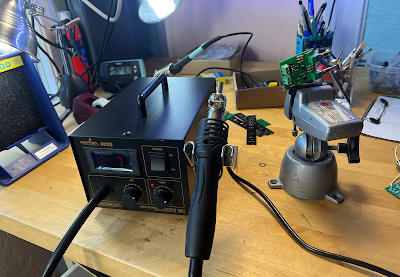Existential Question: Is AudioDiWHY a dating site? Swipe left, swipe right?
Use Arduino to automate the swiping?
Unlikely, but--maybe.
I have brought DiWHY modules to my geeky audio meetups that sound great (well, I think so anyway) but are --fugly?
The guys roll their eyes.
Then I bring in something pretty boring with a neat front panel and layout and they say--dude--cool.
 |
| Swipe right? |
The bench mixer discussed in today's post exemplifies the latter--doesn't do a whole lot, but looks good, enough to get the coffee date, maybe more, I think.
You can read about the first attempt at the layout and what I was trying to accomplish (no not that!)--post is here. I went too fast, got cocky, and made lots of mistakes. Sound familiar?
Fixed it this time, it works, although the L > R callout is backwards on the front panel. Red flag? Deal Breaker? Nope. That's fixed in the gerber I uploaded to the PCBWAY community page for the project.
Ah yes, PCBWAY. Shout out to Wendy! Help out this blog and check 'em out. In fact, please!! click this link to PCBWAY and help this blog out--it will register in their analytics that you read this blog; their community home is here.
OK, Let's look at the butt ugly swipe left frac module this date-worthy mixer replaces:
 |
| But...but..your profile says 5'-10"!!! |
Here's the new one again:
 |
| "AudioDIWHY-- No Catfishing" |
This is a simple bench mixer--audio at input (2 x 2 with normals to handle mono audio) is mixed to 2 screw terminals in the back, which in turn gets connected to a power amp and speakers.
Two op amps, some hardware, dual concentric pots, and a handful of resistors. Dumb! Easy! That's what she said....
 |
| Happiness is new boards from PCBWAY! |
 |
| Soldered in the SOIC op amps. Not too hard to solder, no microscope needed. |
 |
 |
| Test fit....we'll know more after the 4th date. |
 |
| What is it you do for a living? You're a tech right? |
 |
| "A rule--I don't date geeks".....but...wait....you're gainfully employed? |
Not shown in the photos, but it's there: be sure to connect ground on the main board to ground on the jacks board. You can use a 2x 100mil male/female jumper; to get this done fast I soldered 22 gauge single strand hookup wire between the boards.
If you want to take this one home, I posted gerbers, PDFs, Eagle files, BOM, etc. for this module on PCBWAY's Project page--here.
If you build one you will need 3 PCBs: the jacks board, the board with the op amps, and the front panel.
For the front panel I'd recommend black solder mask with white silk; check the box that says for an extra $1.50 don't put the order # on the PCB. Something like that.
Enjoy the swipe right look.
That's it for this one--above all, don't date the fumes. See ya next time.






























